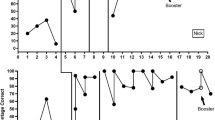Abstract
Training graduate students to promote behavior analysis and counter misconceptions requires that graduate programs in behavior analysis contain a healthy dose of experimental analysis of behavior so that students understand the experimental foundations of their discipline. Moreover, graduate students should be required to study the theoretical and philosophical foundations of the field because most of the misconceptions of behavior analysis are conceptual and philosophical in nature. Programs should also teach graduate ABA students to think critically about the concepts and principles of behavior analysis in order to prepare them to defend it against misunderstandings and to be more effective practitioners.
Similar content being viewed by others
References
Becirevic, A. (2014). Ask the experts: how can new students defend behavior analysis from misunderstandings? Behavior Analysis in Practice.
Cherpas, C. (1993). Do establishing operations alter reinforcing effectiveness? The Behavior Analyst, 16(2), 347–349.
Chomsky, N. (1959). Review of B. F. Skinner’s Verbal Behavior. Language, 35, 26–58.
Deci, E. L. (1971). Effects of externally mediated rewards on intrinsic motivation. Journal of Personality and Social Psychology, 18, 105–115.
Dickinson, A. M. (1989). The detrimental effects of extrinsic reinforcement on “intrinsic motivation”. The Behavior Analyst, 12(1), 1–15.
Donahoe, J. W., Burgos, J. E., & Palmer, D. C. (1993). A selectionist approach to reinforcement. Journal of the Experimental Analysis of Behavior, 60(1), 17–40.
Kestner, J., & Flora, S. R. (1995). Representation of behavioral methodology in experimental psychology textbooks. The Behavior Analyst, 18(2), 385–390.
Morris, E. K. (1985). Public information, dissemination, and behavior analysis. The Behavior Analyst, 8, 95–115.
Premack, D. (1962). Reversibility of reinforcement relation. Science, 136(3512), 255–257.
Roediger, H. L. (2004). What happened to behaviorism? APS Observer, 17(3).
Schlinger, H. D. (2008). The long goodbye: why B. F. Skinner’s Verbal Behavior is alive and well on the 50th anniversary of its publication. The Psychological Record, 58, 329–337.
Schlinger, H. D. (2014a). Publishing outside the box: unforeseen dividends of talking to strangers. The Behavior Analyst. doi:10.1007/s40614-014-0010-5.
Schlinger, H. D. (2014b). B. F. Skinner, psychologist. European Journal of Behavior Analysis, 14(1).
Schlinger, H. D., & Blakely, E. (1994). A descriptive taxonomy of environmental operations and its implications for behavior analysis. The Behavior Analyst, 17(1), 43–57.
Skinner, B. F. (1953). Science and human behavior. New York: Macmillan.
Skinner, B. F. (1974). About behaviorism. New York: Knopf.
Timberlake, W., & Allison, J. (1974). Response deprivation: an empirical approach to instrumental performance. Psychological Review, 81, 146–164.
Todd, J. T., & Morris, E. K. (1983). The misrepresentation of behavior analysis in psychology textbooks: misconception and miseducation. The Behavior Analyst, 6, 153–160.
Todd, J. T., & Morris, E. K. (1992). Case studies in the great power of steady misrepresentation. American Psychologist, 47, 1441–1453.
Wyatt, W. J., Hawkins, R. P., & Davis, P. (1986). Behaviorism: are reports of its death exaggerated? The Behavior Analyst, 9, 101–105.
Author information
Authors and Affiliations
Corresponding author
Rights and permissions
About this article
Cite this article
Schlinger, H.D. Training Graduate Students to Effectively Disseminate Behavior Analysis and to Counter Misrepresentations. Behav Analysis Practice 8, 110–112 (2015). https://doi.org/10.1007/s40617-014-0028-x
Published:
Issue Date:
DOI: https://doi.org/10.1007/s40617-014-0028-x




